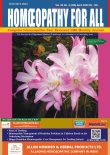Need of Research in Homoeopthy
Keywords:
homoeopathy, medicines, waterAbstract
It is a fact that among all the alternative medical systems, according to the World Health Organization, homoeopathy is the most sought after medical treatment method in the world. A large number of people throughout this planet seek this method of treatment for getting relief from their ailments. As per World Health Organization Report 2019, homoeopathy is used in 100 member states with 22 member states having regulations for providers, while 13 member states have health insurance coverage. In 99 states, the main challenge with regard to regulatory issues is lack of research data. In spite of the above fact and though Homoeopathic treatment has been found to be effective in a number of diseases, in some quarter homoeopathy is still regarded as a pseudo-science. The sceptics always argue that dilution level of homoeopathic medicines is so high that according to classical science no molecule of the original drug material can exist in the dispensed medicine. Till yester years we did not have any answer to this criticism as homoeopathic medicines could not be tested in a laboratory, no instrument was available at that time to detect and differentiate homoeopathic medicines from pure alcohol or water. The only argument we had that we have exhibited number of cures of so called impossible diseases which cannot be denied. But the situation is changing. With introduction of very sophisticated and accurate instruments, apart from our old argument of showing cure, now we can show that homoeopathic medicines are not merely alcohol or water and our medicines are physico-chemically different from them.




